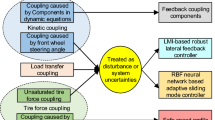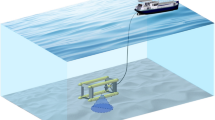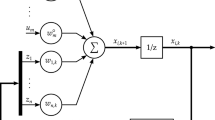Abstract
This study focuses on the pointing control problem of a moving tank gun. Model uncertainty and foundation vibration, which may be nonlinear, coupled, or time-varying but bounded, are considered. First, the electrohydraulic servo system of a vertical stabilizer is constructed as a nonlinear dynamic system with lumped uncertainties. Second, a neural adaptive controller is proposed to improve the control performance of the vertical stabilizer. A back-propagation neural network is introduced to compensate for the uncertainties, and its weight and threshold values are self-tuned online. Third, a co-simulation model of the moving tank is established. Dynamic simulation verifies that the proposed controller exhibits better performance than typical controllers. Finally, the influence of hull foundation vibration on the proposed controller is analyzed. The pointing accuracy of a moving tank gun is verified to be controlled effectively by the proposed controller under different driving conditions. This work combines control theory with multi-body dynamics to provide a feasible solution for the pointing control problem of a moving tank with model uncertainty and foundation vibration.
Similar content being viewed by others
References
M. Bundy, J. Newill, V. Marcopoli, M. Ng and C. Wells, A methodology for characterizing gun barrel flexure due to vehicle motion, Shock and Vibration, 8(3–4) (2001) 223–228.
F. F. Liu, X. T. Rui, H. L. Yu, J. S. Zhang, Q. B. Zhou and W. Zhu, Study on launch dynamics of the tank marching fire, Journal of Shanghai Jiaotong University (Science), 21(4) (2016) 443–449.
F. F. Liu, Y. M. Song, H. L. Yu, W. D. Lin, J. Zhang, Z. H. Si, M. K. Ding and X. T. Rui, Study on the influence of projectile on muzzle disturbance, Defence Technology, 14(5) (2018) 570–577.
A. Jakati, S. Banerjee and C. Jebaraj, Development of mathematical models, simulating vibration control of tracked vehicle weapon dynamics, Defence Science Journal, 67(4) (2017) 465–475.
S. Banerjee, V. Balamurugan and R. Krishna Kumar, Effect of integrated ride and cornering dynamics of a military vehicle on the weapon responses, Proceedings of the Institution of Mechanical Engineers, Part K — Journal of Multi-body Dynamics, 232(4) (2018) 536–554.
Y. Chen, G. L. Yang, Y. C. Fu and Q. Z. Sun, Dynamic simulation on nonlinear vibration of marching tank gun under high mobility conditions, Acta Armamentarii, 40(7) (2019) 1339–1348.
G. S. Wang, L. Y. Yao, L. S. Wei, Y. Piao and L. Gu, Research on the influence of linear vibration of a tank chassis on on-the-move shooting accuracy, Acta Armamentarii, 37(3) (2016) 541–546.
J. F. Zhu, B. J. Zhao and Q. Z. Wang, Modern Tank Fire Control System, National Defense Industry Press: Bei**g (2003).
T. Dursun, F. Buyukcivelek and C. Utlu, A review on the gun barrel vibrations and control for a main battle tank, Defence Technology, 13(5) (2017) 353–359.
Y. Chen, G. L. Yang, H. G. Zhou and Q. Z. Sun, Sequential approximate optimization on projectile disturbances of the moving tank based on BP neural network, Journal of Mechanical Science and Technology, 35(3) (2021) 935–944.
Y. Chen, G. L. Yang, H. G. Zhou and J. F. Liu, Influence of projectile-barrel coupling on gun vibration of the moving tank under the influence of a stabilizer, Arabian Journal for Science and Engineering, 46 (2021) 7635–7648.
H. **an, W. Yang, W. D. Zhang, X. M. Duan and H. Y. Yu, The application of dual-PID regulation based on sliding mode control in a tank artillery stabilizer, 4th International Conference on Intelligent Computation Technology and Automation (2011) 731–733.
Q. Gao, G. L. Yang, L. J. Ji, Z. Sun and R. M. Hou, A semiadaptive fractional order PID control strategy for a certain gun control equipment, International Conference on Instrumentation, Measurement, Circuits and Systems (2012) 223–226.
Q. Gao, J. L. Chen, L. Wang, S. Q. Xu and Y. L. Hou, Multiobjective optimization design of a fractional order PID controller for a gun control system, Scientific World Journal, 2013 (2013) 907256.
Q. Q. Sun, X. Y. Wang and Y. H. Chen, Adaptive robust control for dual avoidance-arrival performance for uncertain mechanical systems, Nonlinear Dynamics, 94(2) (2018) 759–774.
J. H. Li and G. H. Yang, Fuzzy descriptor sliding mode observer design: a canonical form-based method, IEEE Transactions on Fuzzy Systems, 28(9) (2020) 2048–2062.
Y. Liu, B. X. Jiang, J. Q. Lu, J. D. Cao and G. P. Lu, Event-triggered sliding mode control for attitude stabilization of a rigid spacecraft, IEEE Transactions on Systems, Man, and Cybernetics: Systems, 50(9) (2020) 3290–3299.
W. He, T. T. Meng, X. Y. He and S. S. Ge, Unified iterative learning control for flexible structures with input constraints, Automatica, 96 (2018) 326–336.
W. He, T. T. Meng, D. Q. Huang and X. F. Li, Adaptive boundary iterative learning control for an Euler-Bernoulli beam system with input constraint, IEEE Transactions on Neural Networks and Learning Systems, 29(5) (2018) 1539–1549.
Y. C. Wang, L. F. Zheng, H. G. Zhang and W. X. Zheng, Fuzzy observer-based repetitive tracking control for nonlinear systems, IEEE Transactions on Fuzzy Systems, 28(10) (2020) 2401–2415.
V. P. Vu and W. J. Wang, Polynomial controller synthesis for uncertain large-scale polynomial T-S fuzzy systems, IEEE Transactions on Cybernetics, 51(4) (2021) 1929–1942.
J. P. Cai, R. Yu and Q. Z. Yan, Event-triggered adaptive control for tank gun control systems, IEEE Access, 7 (2019) 17517–17523.
Y. Chen, G. L. Yang and Q. Z. Sun, Dynamic simulation on vibration control of marching tank gun based on adaptive robust control, Journal of Low Frequency Noise, Vibration and Active Control, 39(2) (2020) 416–434.
Y. Ma, G. L. Yang, Q. Q. Sun, X. Y. Wang and Q. Z. Sun, Adaptive robust control for tank stability: a constraint-following approach, Proceedings of the Institution of Mechanical Engineers, Part I — Journal of Systems and Control Engineering, 235(1) (2021) 3–14.
Q. Gao, Y. L. Hou, J. B. Liu, R. M. Hou, M. M. Lv, L. Wang and C. Wang, An extended state observer based fractional order sliding — mode control for a novel electro — hydraulic servo system with ISO — actuation balancing and positioning, Asian Journal of Control, 21(1) (2019) 289–301.
Q. Y. Yang, Q. Z. Yan, J. P. Cai, J. H. Tian and X. H. Guan, Neural network-based error-tracking iterative learning control for tank gun control systems with arbitrary initial states, IEEE Access, 8 (2020) 72179–72187.
Q. Q. Sun, X. Y. Wang, G. L. Yang, Y. H. Chen and P. Duan, Robust pointing control of marching tank gun with matched and mismatched uncertainty, IEEE Transactions on Cybernetics (2021) (online first).
J. Hu, P. F. Wang, C. C. Xu, H. B. Zhou and J. Y. Yao, High accuracy adaptive motion control for a robotic manipulator with model uncertainties based on multilayer neural network, Asian Journal of Control (2021) (online first).
Q. Guo and Z. L. Chen, Neural adaptive control of single-rod electrohydraulic system with lumped uncertainty, Mechanical Systems and Signal Processing, 146 (2021) 106869.
M. Yue, L. J. Wang and T. Ma, Neural network based terminal sliding mode control for WMRs affected by an augmented ground friction with slippage effect, IEEE/CAA Journal of Automatica Sinica, 4(3) (2017) 498–506.
M. S. Turgut and M. T. Çoban, Neural network predictive control of a vapor compression cycle, Arabian Journal for Science and Engineering, 45 (2021) 779–796.
S. Zhang, Y. T. Dong, Y. C. Ouyang, Z. Yin and K. X. Peng, Adaptive neural control for robotic manipulators with output constraints and uncertainties, IEEE Transactions on Neural Networks and Learning Systems, 29(11) (2018) 5554–5564.
H. Y. Wang and J. H. Qiao, Robust control research on adaptive wavelet neural network identification for tank all-electric gun control system, International Conference on Intelligent Control and Information Processing (2011) 375–379.
X. Ma, W. X. Deng, S. S. Yuan, J. Y. Yao and G. L. Yang, Neural network based adaptive rise control of tank gun systems, Journal of Physics Conference Series, 1507 (2020) 052001.
L. Zhang, F. L. Wang, T. Sun and B. Xu, A constrained optimization method based on BP neural network, Neural Computing and Applications, 29 (2018) 413–421.
H. K. Khalil, Nonlinear Systems, Prentice-Hall, Upper Saddle River (2002).
H. B. Ren, S. Z. Chen, Z. C. Wu and Z. Z. Feng, Time domain excitation model of random road profile for left and right wheels, Transactions of Bei**g Institute of Technology, 33(3) (2013) 257–259, 306.
B. F. Hao, H. Y. Wang, Q. Rui and Q. L. Wang, Dynamic modeling and model test verification of tank multi-body systems, China Mechanical Engineering, 29 (2018) 429–433.
Acknowledgments
This work was supported jointly by the National Natural Science Foundation of China (Grant No. 52105102), the Natural Science Foundation of the Higher Education Institution of Jiangsu Province (Grant No. 21KJB570008), and the Youth Science and Technology Innovation Foundation of Jiangsu University of Science and Technology (Grant No. 1022922001).
Author information
Authors and Affiliations
Corresponding author
Additional information
Yu Chen is a Lecturer at the School of Mechanical Engineering, Jiangsu University of Science and Technology, Zhenjiang, China. He obtained his Ph.D. from Nan**g University of Science and Technology. His research interests include numerical simulation, vibration and control, and dynamics analysis.
Rights and permissions
About this article
Cite this article
Chen, Y., Cai, Y., Yang, G. et al. Neural adaptive pointing control of a moving tank gun with lumped uncertainties based on dynamic simulation. J Mech Sci Technol 36, 2709–2720 (2022). https://doi.org/10.1007/s12206-022-0504-0
Received:
Revised:
Accepted:
Published:
Issue Date:
DOI: https://doi.org/10.1007/s12206-022-0504-0




